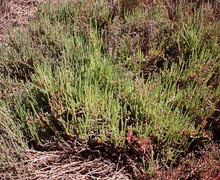Tecticornia
| Tecticornia | |
|---|---|
 |
|
| Samphire, Tecticornia pergranulata | |
| Scientific classification | |
| Kingdom: | Plantae |
| (unranked): | Angiosperms |
| (unranked): | Eudicots |
| (unranked): | Core eudicots |
| Order: | Caryophyllales |
| Family: | Amaranthaceae |
| Subfamily: | Salicornioideae |
| Genus: |
Tecticornia Hook. f. |
| Species | |
|
ca. 44 species, see text. |
|
ca. 44 species, see text.
Tecticornia is a genus of succulent, salt tolerant plants largely endemic to Australia. Taxa in the genus are commonly referred to as samphires. In 2007, the genus Halosarcia, along with three other Australian genera (Pachycornia, Sclerostegia and Tegicornia) was incorporated into the genus.
The species of Tecticornia grow as annual or perennial herbs, subshrubs or small shrubs. Stems are branched, glabrous and appear jointed. The opposite leaves are fleshy, glabrous, connate in the lower part and cup-like or collar-like stem-clasping, with minute (0-3 mm long) two-lobed to triangular leaf blades.
The spike-shaped inflorescences consist of opposite bracts, mostly connate and stem-clasping, free in some species. Their blades are cup- or collar-like or deltoid to semi-circular scales. In the axil of each bract, there are three to five (rarely one or seven) flowers, free or sometimes fused to each other, to the bract, and to the inflorescence axis. The flowers are hermaphrodite, rarely unisexual. They consist of a 2-3-lobed perianth of connate tepals, one stamen, and an ovary with two stigmas.
In fruit, the perianth remains membranous or becomes crustaceous, spongy, or horny. The fruit wall (pericarp) may be membranous, fleshy, crustaceous, or woody. The seed is disc-shaped or wedge-shaped, its seed coat with smooth or reticulate, tuberculate or longitudinally ribbed surface. The seed contains the curved embryo and copious perisperm (feeding tissue).
All species of Tecticornia are distributed in Australia. Only one species, Tecticornia indica (Syn. Halosarcia indica, Arthrocnenum indicum) has a wider range outside this continent along the tropical coasts of the Indian Ocean to eastern and western tropical Africa.
...
Wikipedia
